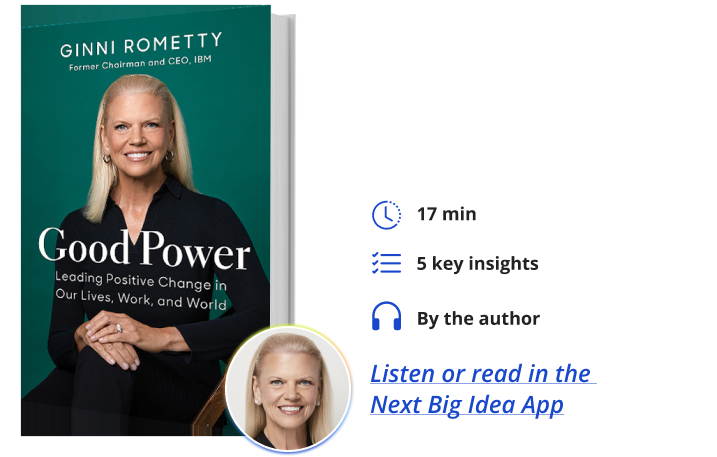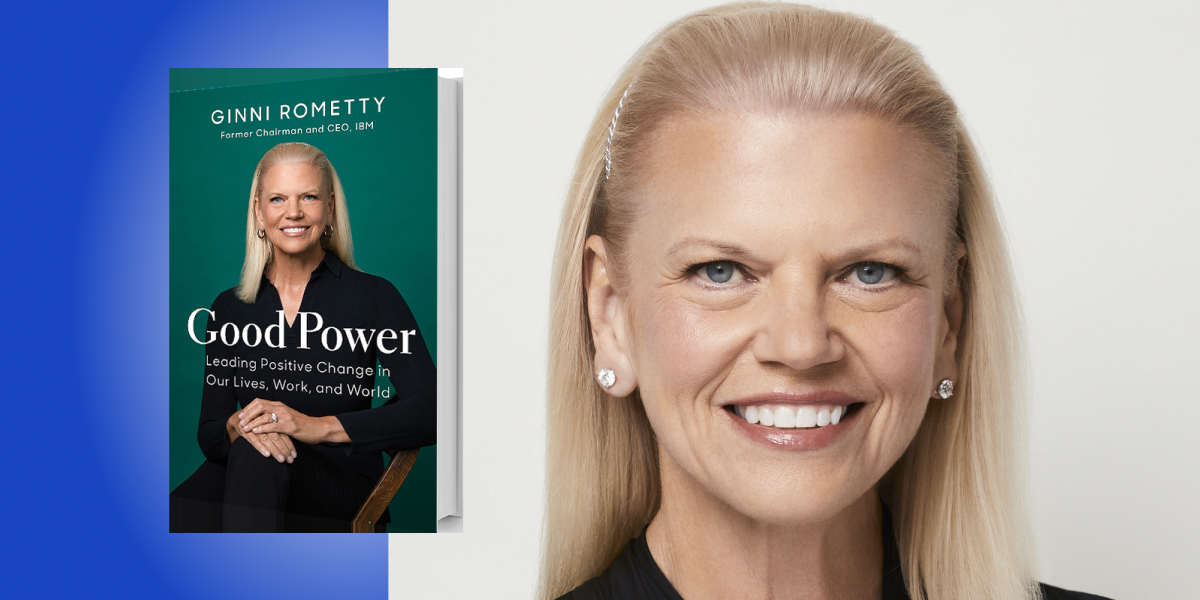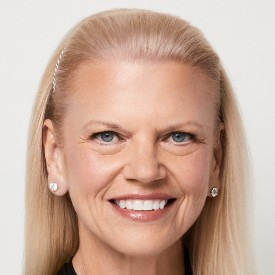Ginni Rometty is the former CEO of IBM and co-chair of OneTen. She was named one of Bloomberg’s 50 Most Influential People in the World and one of Fortune’s 50 Most Powerful Women in Business.
Below, Ginni shares 5 key insights from her new book, Good Power: Creating Positive Change in our Lives, Work, and World. Listen to the audio version—read by Ginni herself—in the Next Big Idea App.

1. Be in service of.
Being in service of others is different from serving others. When we’re “in service of” others, our priority is to make someone or something better by helping them reach their potential. As a result, we take a little bit of a leap of faith that our own needs are then fulfilled.
Think about it this way: A waiter in a restaurant can serve you a meal but not really care if you enjoy yourself. In contrast, waiters that want to be in service of their guest try to create an enjoyable experience. As a result, they may get a bigger tip, but creating the experience was their first priority.
This principle is the soul of good power, because being in service of others is good power’s fundamental purpose, the reason why we seek change.
In business, we try to be in service of our customers, clients and coworkers by adding value to their lives and organizations. I first learned how to add value when I was a very young consultant, and my managers taught me that analyzing a client’s business was just a first step—the analysis was never the goal. We had to extract the “ah-ha.” Extracting the “ah-ha” meant coming up with new ideas and recommendations that would improve a client’s business. Similar to a waiter in a restaurant, my intent was to go beyond finding problems by delivering a solution.
Here’s another example: We’re in service of coworkers and employees when we treat them with respect and dignity, and when we help them advance their careers. As a leader, try to give people opportunities to learn new skills so they may improve and progress. When people around us grow, everyone benefits. Being “in service of” is about prioritizing others’ needs before our own, and delivering something of value. It is not a means to an end, but a means in and of itself.
2. Build belief.
Trying to affect positive change is rarely, if ever, a solo endeavor. It’s hard to achieve anything of real meaning on our own. We need others to believe in the alternate reality we envision and to willingly help us create it. When we “build belief,” we win people’s voluntary, enthusiastic buy-in and unleash their discretionary effort.
So much of building belief is an emotional, personal endeavor, which is why it is referred to as good power’s heart. The opposite of building belief is ordering people to do something they don’t really buy into and expecting them to perform as if they did. Change fueled by authority or fear is not sustainable. People should follow leaders and execute change because they choose to.
Years before I became CEO, I learned the power of building belief when IBM made a major acquisition and bought PricewaterhouseCoopers Consulting (PwCC). We bought it to grow our existing consulting business. I was put in charge of bringing the independent consultants into IBM’s corporate culture. Bringing together a private partnership with a public company was and is tricky. We weren’t acquiring products, but people with hearts and minds who could walk away at any time.
“Change fueled by authority or fear is not sustainable.”
I needed the PwCC consultants to want to be part of IBM. To achieve that, they had to feel that their ideas, their individuality, and their needs were valued. I met with people one-on-one to understand what was important to them, and did a lot of listening. Even though IBM had technically acquired the consultants, I always referred to it as a merger because the word connoted a coming together of equals instead of just folding PwCC’s people into IBM’s ways.
Rather than force fit them into our way of working, we co-created a new business unit that incorporated policies from PwCCs culture, like keeping the title of “partner.” Ultimately, I tried to preserve enough of the consultants’ way of life to make them feel a sense of belonging, while at the same time making choices that made sense for the new business. Of course, the merger wasn’t without its challenges, but by 2008 our consulting practice had almost $20 billion in revenues, in part because the vast majority of the PwCC partners were still with IBM.
Whatever our mission, we’re more likely to achieve it if we can bring people along with us by touching people’s emotions as well as their intellect. That is how we build belief.
3. Know what must change and what must endure.
This principle is good power’s brain because it’s about the critical thinking and problem solving that’s required to transform something old into a new, better state. Change in any context and at any scale requires making hard choices about what things to preserve and what to reimagine.
As you change jobs, for example, you may need to update your skills and knowledge, but you don’t want to abandon your core values or you can’t be true to who you are in your new job. This also applies to organizations that need to change.
During my time as IBM’s CEO, we had to reinvent the company. IBM was a century-old, profitable, multi-billion-dollar corporation, but we were also falling behind younger, more agile competitors. If we didn’t change, we would not survive. But we also couldn’t become a completely different company. As someone wise said to me, “IBM would make a horrible Google, and Google would make a horrible IBM.” We had to become a better version of ourselves.
While sitting in a room we called the library, which was constructed from our founder’s original office, I thought about what it meant to uphold a legacy while staying relevant in the present. I asked myself what had to change? We needed a new technology platform, one in the cloud. What had to endure? Our fundamental purpose was to be essential to thousands of clients. IBM runs big, complex systems. Without us, banks couldn’t operate. Railroads couldn’t function. Airlines couldn’t fly. The world could not afford for IBM to go away, yet we couldn’t afford to stay the same. Over the course of a few years, we made difficult choices, like divesting businesses and innovating new ones. We eventually found our place on the cloud and built our then hybrid-cloud platform that met our clients’ uniquely complex needs. In short, our mission endured, but with a new technology platform.
“The world could not afford for IBM to go away, yet we couldn’t afford to stay the same.”
The other thing we had to change was how we worked as a company. We had to become more collaborative, more customer focused, and faster to market. We hired people with skills we lacked, but we also invested in massive education initiatives for our existing employees, and trained tens of thousands of people in design-thinking, agile, and AI. By 2020, eight out of every IBMers had skills for the future.
Change isn’t about replacing one thing for another, but finding creative ways to integrate the past and the future. We do this by thinking critically about what must change and what must endure.
4. Steward good tech.
Even if you don’t work in the tech industry, we all use technology in our personal and professional lives. We are all in a position to make choices about whether technology is being used ethically. In fact, stewarding good tech means taking responsibility for both the upsides and the downsides of technology, even in the long term. Tech companies in particular have a responsibility to make sure the technologies they create and sell are developed and managed ethically, too.
There are many ways to steward good tech. As an individual, we can choose not to post false information on social media. An AI startup can staff its engineering teams with people from different backgrounds so the AI products being built reflect the diversity of many users.
If society is going to flourish in our digital age, people must trust that technology will lead them to a brighter future, not a darker place. People’s trust in technology began to deteriorate during the past decade, in the wake of security breaches, questions about how companies handle people’s personal data, and fears that new technologies would make jobs obsolete. Earning and preserving trust is essential to being a steward of good tech.
One way to do this is to ensure that more people have access to all the good tech jobs being created. We did this at IBM when we were having trouble filling tech positions in cybersecurity. The candidate pool just wasn’t big enough. Eventually, we figured out that a lot of the skills our unfilled jobs required did not have to be learned in a traditional college setting. The skills could be acquired from other types of education, like boot camps, community colleges, or apprenticeships. So, we eliminated four-year degrees from many job postings, and instead, we articulated the skills people needed. The revised criteria helped us tap into new pools of potential hires. It was so successful we expanded this “Skills First” hiring practice to almost all our other jobs.
As more and more employers emphasize skills over degrees when they recruit and promote people, they are opening the workforce to overlooked talent, filling open positions more quickly, and making their workplaces more diverse. They are also being stewards of good tech.
Technology should augment humanity, not cause undue harm. It’s not always easy when there is a lot of pressure to deliver results or get instant feedback, which is why stewarding good tech is considered the muscle of good power. It takes strength to do what’s right for the long term, for the many, and not just the few.
5. Be resilient.
Change is hard, especially when it’s ambitious. The higher the goal, the harder the climb. Obstacles and missteps are inevitable. But we don’t want to let a crisis derail our plans, or naysayers shake our confidence. When we’re committed to creating positive change, we need to stay the course.
“Resilience results from two factors—relationships and attitude.”
Resilience has allowed me to forge ahead when faced with disappointment, setbacks, conflict, and critics. In my experience, resilience results from two factors—relationships and attitude.
The right relationships give us perspective when times get tough. People we trust can help us judge something’s true importance, or see it from another angle. They also fuel our energy and are a source of support. Mark, my husband of over 43 years, has always been the most important relationship in my life. One time, years ago, I came home from work and told Mark that I was offered a promotion. The possibility made me very uncomfortable because I did not think I was ready for it, and I told my boss that. When Mark heard what I had done, he asked me one question. “Do you think a man would have answered it that way?” His observation made me pause. His point wasn’t just about differences between men and women, but about choosing to be comfortable with discomfort, and to see my own potential versus potential pitfalls. Mark knew my potential, and he reminded me to see it, too. The next day I accepted the job.
Attitude is another source of resilience because it’s how we choose to deal with challenges. The most difficult goals take time to come to fruition. A leader’s attitude—optimism versus fear, calm versus panic—will shape other people’s attitudes and their ability to do the job.
When it comes to conflict, for example, my attitude is to face it head-on, and see it as an opportunity to improve a situation. Running toward conflict takes courage and often humility, but it is so much more productive.
When it comes to critics, I don’t plug my ears but listen to see what can be learned. I also try not to absorb criticism too emotionally. My attitude is to let critics inform me, but not define me.
We all have the power to choose our relationships and attitude. When we chose well, we can be more resilient, and not let problems set us back. Resilience is good power’s unwavering spirit.
To listen to the audio version read by author Ginni Rometty, download the Next Big Idea App today:





























